Expert's Rating
Pros
- Great matte display
- Solid-feeling design
- Repairable and upgradeable with ease
- Powerful Intel chips across the line
- Nice keyboard
- Electrical disconnects for mics and camera
Cons
- Weak battery life
- Expansion Modules drive price up for some ports
- Loud fan kicks on under moderate load
Our Verdict
Come for the repairable, upgradeable design and swappable ports. Stay for the great screen and powerful processor.
It’s 2023 and things are a little dystopian in the laptop space. Users, more concerned with flashy design and light weight than functionality, are flocking to devices that can’t be repaired or upgraded. That’s what makes the Framework Laptop 13 something unique. It’s from a small startup that wants you to have a reliable, long-lasting device that you can use for years to come. If some competitors are fast fashion from Shein, then Framework’s aiming to be the American Giant hoodie of laptops–not the cheapest, but built for the long haul.
To that end, the Framework includes a screwdriver in the box, and has a unique system of modular ports that can be swapped out and changed as needed. It also has RAM and an SSD that can be exchanged for commodity parts in minutes instead of requiring new chips need to be soldered onto the motherboard.
All of this sounds good on paper, but aside from its marketing bullet points, is it a good laptop? Let’s find out.
Looking for more options? Check out PCWorld’s roundup of the best laptops available today.
Framework Laptop 13: Specs
Our review unit came equipped with an Intel Core i7-1360P CPU, Intel Iris Xe graphics, 16GB of RAM, and 512GB of NVMe PCIe SSD storage. For more details, check out the bulleted list below:
- CPU: Intel Core i7-1360P (12 cores, 16 threads, 4 performance cores, 8 efficiency cores)
- Memory: 16 GB LPDDR5 (2x 8 GB SODIMMs, user upgradeable)
- Graphics/GPU: Intel Iris Xe Graphics
- Display: 13.5-inch 2356×1504 3:3 matte IPS LCD, >400 nits peak brightness
- Storage: 512 GB M.2 NVMe PCIe 4.0 SSD
- Webcam: 1080p IR camera with hardware killswitch
- Connectivity: 4x Thunderbolt 4 with other ports selectable with Expansion Cards (four included), 3.5 mm headset jack
- Networking: Intel AX210 with Wi-Fi 6E, Bluetooth 5.3
- Biometrics: Fingerprint scanner
- Battery capacity: 61Wh
- Dimensions: 11.66 W x 8.52 L x 0.46 H inches
- Weight: 2.86 pounds, TKTK pounds with AC adapter
- Price as Reviewed: $1,469
Framework Laptop 13: Design and build quality

IDG / Brendan Nystedt
From photos, the Framework Laptop 13 looks generic. It’d win at least runner-up in a MacBook Air lookalike contest, with its black chiclet keyboard and silver, tapered design. The Framework gear logo on the back of the screen seems like some kind of optical illusion–you can see but it’s so inoffensive you’re unlikely to recall it. Going hands-on with the device, I was struck by how much it looks like the renders, but thankfully what’s kind of a meh design is backed up by robust engineering.
A part of the Framework Laptop’s design is its aforementioned repairability. This machine has been designed to be opened quickly, with only 5 screws holding the keyboard down, and magnets helping the rest stick together. That could have been a recipe for flimsiness, but not in the case of the Framework Laptop 13. Not only is this relatively thin device easy to pop open, but it also feels like it could survive long enough to get repairs and upgrades down the road. At this point, Framework has made three generations of compatible Intel Framework 13 motherboards, and is throwing an AMD Ryzen-based motherboard into the mix later this year. Based on this level of support, we’re hopeful that you have a chance at upgrading this Framework 13 with a more performant motherboard in the years to come.
And if the design is a little generic-looking to you, you can at least add a few custom parts into the mix. Framework themselves offer up replacement display bezels in transparent, and a few colors that should add a nice pop to your system. There are also alternative keyboards in black and clear for you 1337 users who don’t need legends on your keycaps. The entire computer uses a blend of new and pre- or post-consumer materials, which is nice to see.
Framework Laptop 13: Connectivity
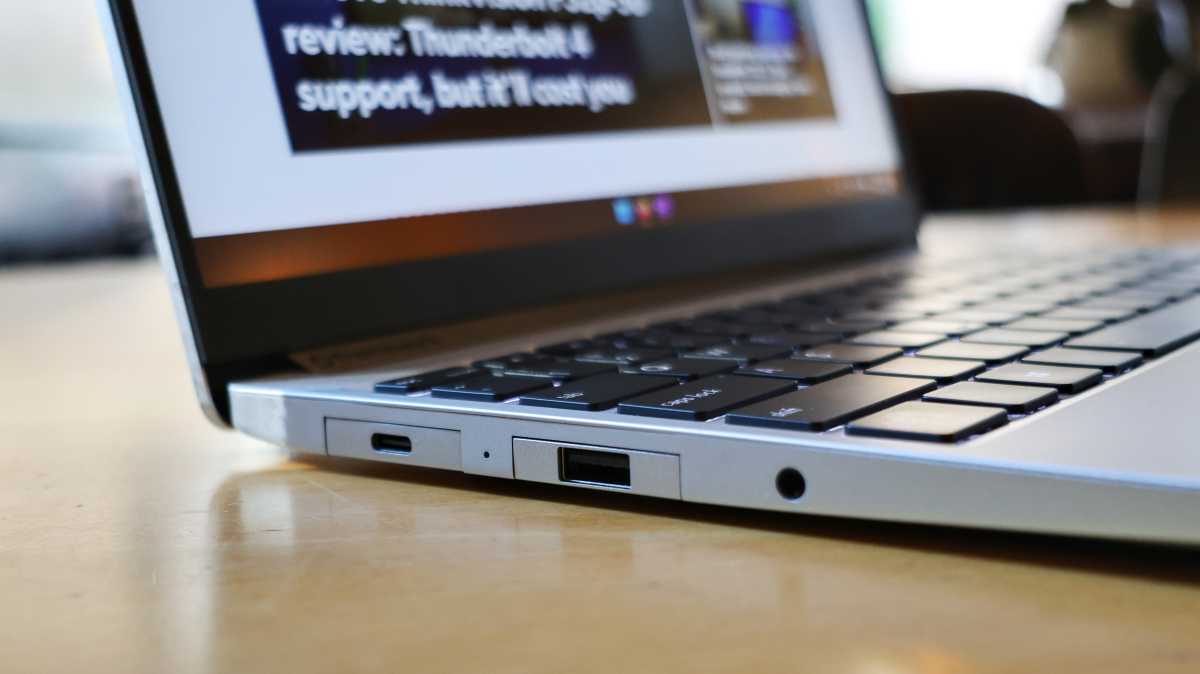
IDG / Brendan Nystedt
More than with any other laptops, you’ll need to plan ahead when selecting a Framework system. You see, these computers don’t have physical ports by default, instead giving you four small bays that can fit a range of different “Expansion Cards”. On paper, this setup is more flexible than other competing laptops, letting you decide what ports you’ll need when. It could also make a repair easier, if, for instance, a USB port is acting flaky, the module slides neatly out of the machine and can be swapped in seconds.
But realistically, this design still leaves you with only three port choices, since one of which will always need to be a USB-C module for charging (there’s no DC-in barrel jack on the Framework Laptop 13, even though there is a headset jack). Additionally, some ports cost more to add to your laptop at purchase, with an extra $10 fee per HDMI, microSD (where’s the full-size SD option?), or DisplayPort, and $30 extra dollars for ethernet. Competing systems like a super thin Asus ZenBook 13 OLED I tested recently crams in a far better array of ports (2x USB-C, HDMI, USB-A) and even Apple’s 14 and 16-inch MacBook Pros come with more ports now (3x USB-C, HDMI, MagSafe for charging, with an SD card slot too)–and you don’t have to pay extra for the privilege. Modularity has some benefits here, but the tradeoffs are real, too.
For wireless, the Framework Laptop 13 has an Intel WiFi 6E AX210 card by default, but can be configured with the AX210 with vPro if your company needs that kind of management. Both cards come with Bluetooth 5.3 standard. The antennas inside gave me consistent, reliable connection both in my apartment and in a couple of local cafes, one of which occasionally has WiFi that is flaky when a lot of users jump on the network.
Framework Laptop 13: Keyboard and trackpad

IDG / Brendan Nystedt
If you need to type long papers or code for days at a time, the Framework Laptop 13 has a keyboard that can keep up with you. Thanks to its comfortable key throw, satisfying actuation, and pillowy keycaps, I was up and typing on the Framework Laptop 13 in no time whatsoever. The layout is fairly normal, but has a forward slash and an enter key that are right next to each other, probably to accommodate international keyboard layouts in the same chassis, often which use an inverted-L shaped enter key. If I had any minor quibble with this keyboard it’s that there is no light to indicate whether or not the function lock is enabled, but the default behavior is to have the function keys act as their labelled shortcut (volume, screen brightness, multimedia etc.) rather than F1-F12.
The trackpad is big, smooth, and generally nice to use. Like with some other modern PC laptops, I find that occasionally the palm rejection goes haywire, skipping my cursor around while I position my hands over the keyboard to start typing. When you go to click, you’ll feel a tactile button instead of a haptic linear motor, which can let you click more consistently across the surface instead of along the bottom half.
Framework Laptop 13: Display, speakers, and webcam
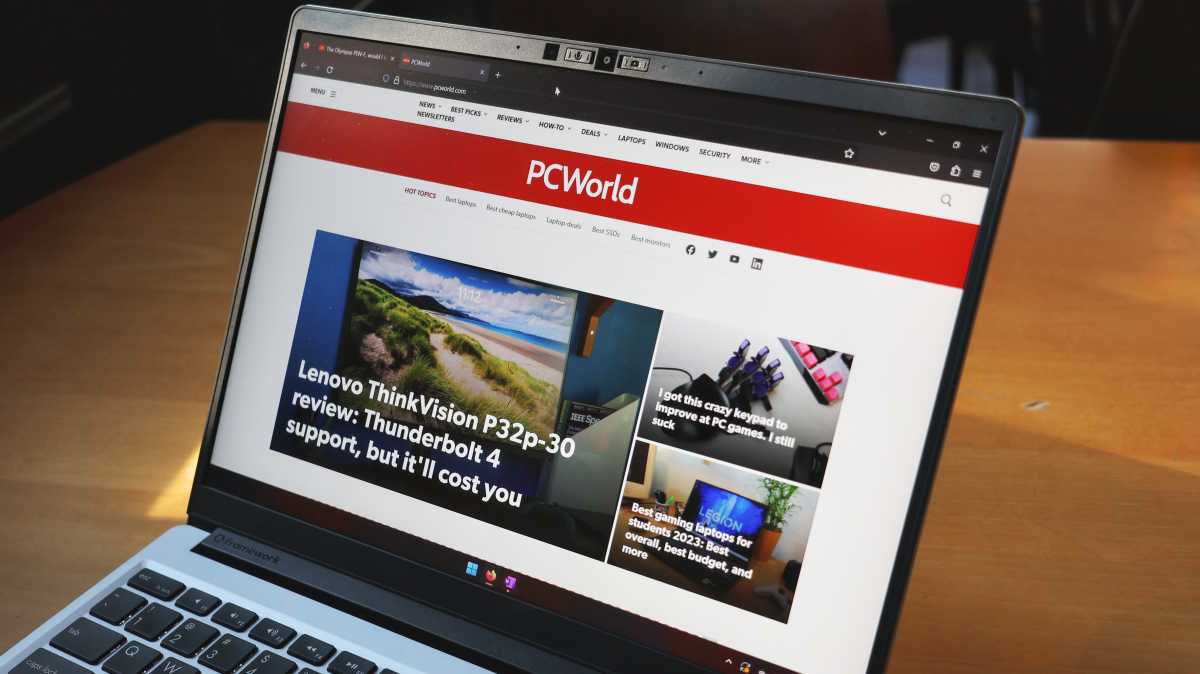
IDG / Brendan Nystedt
On paper, the Framework Laptop 13’s new matte screen doesn’t seem that exciting. After all, competing laptops have higher resolutions, cooler display technologies like OLED or microLED, or aesthetic tweaks like rounded corners and notches for the webcam. I’m here to tell you that you should get excited for the vivid, constrasty, bright 3:2 IPS panel in this computer, because it’s super nice to use. At 2256×1504, you’ll have a tough time seeing pixels, and I found that I had plenty of room at 150% scaling in Windows 11 to see a lot of content at a time. The only time when this tall screen falls flat is when you pull up a widescreen streaming show or YouTube video, since big black bars will show up on the top and bottom. If you’re working a lot on the go, there still is no replacement for a glare-cutting matte screen.
Framework made some noise (get it?) about the 2023 Laptop 13’s improved speakers, and I have to say that they’re better than I expected. While you won’t get thumping bass from these two small down-firing drivers, they get nice and loud, while keeping midrange sounds clear and easy to hear. I found that the Framework Laptop 13 has good enough volume for enjoying human voices and dialogue, but didn’t do the booming sounds of the Oppenheimer trailer justice like multi-speaker systems in competing computers.

IDG / Brendan Nystedt
If you’re the type of person who slaps on a webcam cover the minute your new laptop is out of the box, you’re going to love the Framework Laptop 13. This computer goes further than others, not just putting a little shutter or a deactivation button on the keyboard, but by including a physical switch that disconnects the camera and microphones independent of the operating system. The camera itself is a 1080p unit that’s nothing to write home about (I found it to produce a soft image in a decently-lit cafe), flanked by the aforementioned security switches, an ambient brightness sensor, two microphones, and a webcam indicator light.
Framework Laptop 13: Performance
The Framework Laptop 13 justifies its higher price by including only spicier P-rated chips inside the Intel-powered version. The Intel Core i7-1360P inside the version I tried is the mid-tier chip for Framework’s lineup. That said, it’s surprisingly powerful with its blend of four performance cores with eight efficiency cores, for a total of 16 threads. In our tests, it performed very well, albeit with a bit of fan noise and heat when the chip puts all its cores to work.
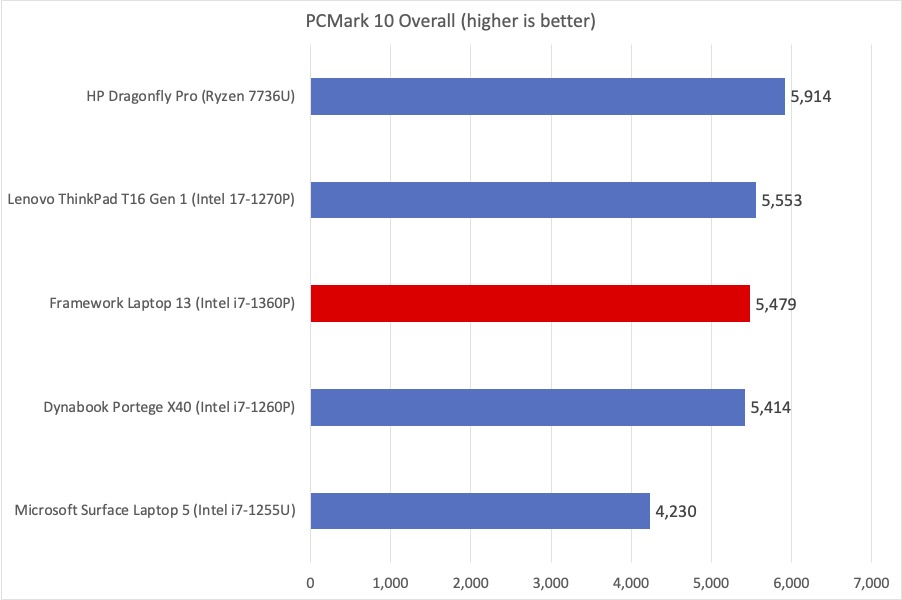
IDG / Brendan Nystedt
We benchmark every laptop we try with PCMark 10. This software gives us a realistic baseline, using everyday tasks in a gauntlet. We saw mid-pack performance for a performance-minded thin laptop. The Framework Laptop 13 will definitely perform well in everyday tasks like web browsing, video chats, and in office applications.
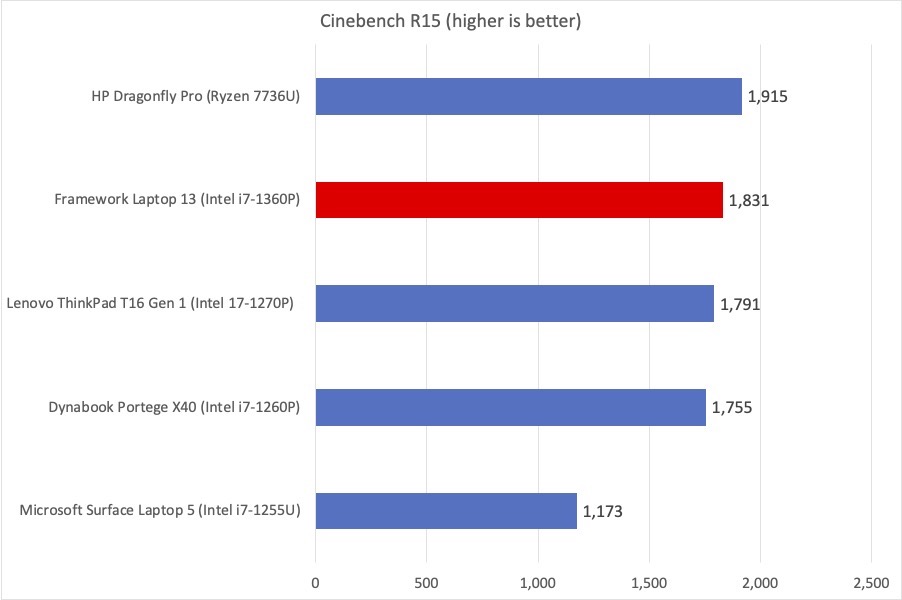
IDG / Brendan Nystedt
In this performance test, we use Cinebench R15 to get a sense for how well all a laptop’s many processor cores team up for intensive rendering tasks. In our tests, the Framework Laptop 13 performed only about as well as last generation’s Intel P-class parts, but it’s an admirable result nonetheless.
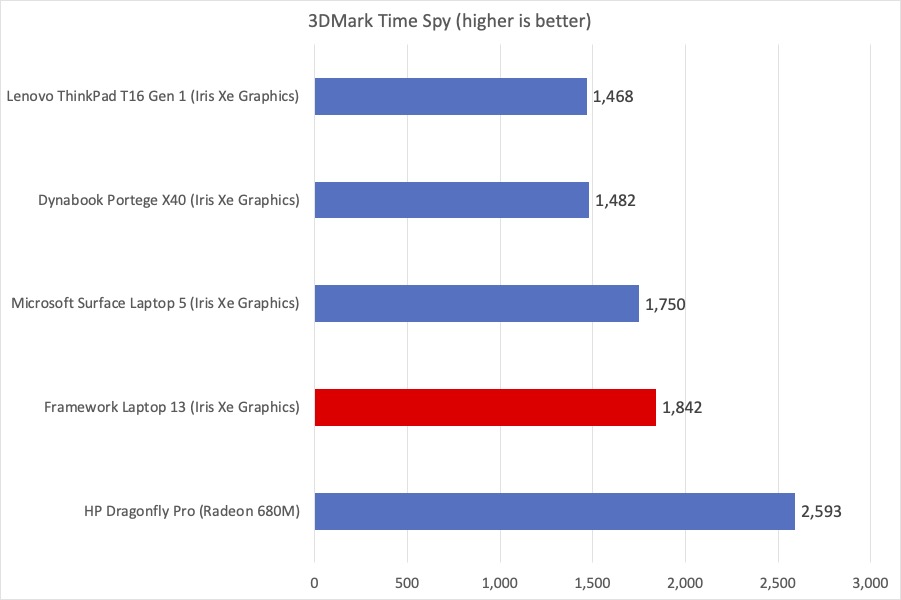
IDG / Brendan Nystedt
3D tasks, not just games, are an important part of modern PC life and that’s why every laptop we review gets tested with 3DMark’s Time Spy benchmark. In this test, the Framework Laptop 13 did decently for a machine with Intel’s integrated Xe Graphics, but it was embarrassed by the GPU cores included with the AMD Ryzen-based HP Dragonfly.

IDG / Brendan Nystedt
We test every laptop by reencoding a high-res video file into a file meant for a small-screened tablet. Thanks to its powerful cores, the Framework Laptop 13 turned in great results in this test, crunching through the video file in a little over 22 and a half minutes, almost keeping pace with the otherwise more performant AMD Ryzen-based HP Dragonfly Pro.
Framework Laptop 13: Battery Life

IDG / Brendan Nystedt
The biggest drawback of an Intel P-class chip in a laptop like the Framework Laptop 13 is a hit to battery life. We measured only a little past six and a half hours in our looping video test, which is definitely behind laptops based around U-class Intel processors and far from the mobile-centric Snapdragon chips. Even with a bigger 61Wh battery in this model, you’ll need to keep a close eye on the battery gauge throughout the day. In our experience, we saw a drop of 18 percent per hour under light usage with a handful of apps open while browsing the web and running YouTube in the background.
Framework Laptop 13: Should you buy it?
While its sustainable marketing and repairable design are certainly noteworthy, the Framework Laptop 13 is itself a solid laptop. This level of documentation and smart design is usually reserved for enterprise-grade notebooks in the ThinkPad, Latitude, or EliteBook series from the big manufacturers, it’s refreshing to see Framework make repairability a mainstream feature, in a laptop that’s mainstream-friendly. Framework gives individuals the power to repair or upgrade, and even throw a still-working motherboard into a case for use on a desktop. All of this is not just begrudgingly accessible to hardware hackers, but easily done by anyone with the (included) screwdriver.
If the environment and sustainability are top of mind for you, buying a previous-gen or refurbished model from Framework’s store is likely a greener way to grab one of these devices. And I would have preferred to see a design that by default has more than four of a single kind of port–the Expansion Cards feel more like a gimmick right now, and force you to spend more money for specialized ports that would otherwise be included in the price. All my gripes aside, with its faster chips and great new matte display, the Intel 13th gen-based Framework Laptop 13 is very nice, and a computer that actually has a chance at serving you for years to come with repairs and upgrades.




